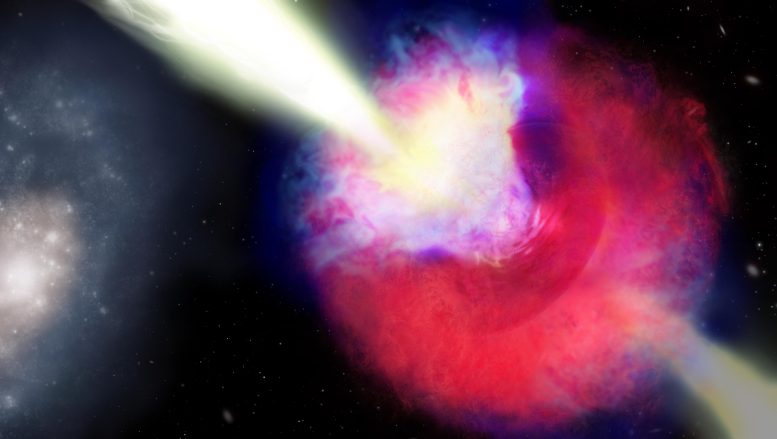
Artist’s impression of GRB 211211A. The kilonova and gamma-ray burst is on the right. The blue color represents material squeezed along the poles, while the red colors indicate material ejected by the two inspiralling neutron stars that is now swirling around the merged object. A disk of ejecta emitted after the merger, hidden behind the red and blue ejecta, is shown in purple. A fast jet (shown in yellow) of material punches through the kilonova cloud. The event occurred approximately 8 kiloparsecs from its host galaxy (left). Credit: Aaron M. Geller/Northwestern/CIERA and IT Research Computing Services
Long Gamma-Ray Bursts Can Be Generated by Neutron Star Mergers
For nearly two decades, astrophysicists have believed that long gamma-ray bursts (GRBs) resulted solely from the collapse of massive stars. Now, a new study upends that long-established and long-accepted belief.
Led by Northwestern University, a team of astrophysicists has uncovered new evidence that at least some long GRBs can result from neutron star mergers, which were previously believed to produce only short GRBs.
After detecting a 50-second-long GRB in December 2021, the team began searching for the long GRB’s afterglow, an incredibly luminous and fast-fading burst of light that often precedes a supernova. But, instead, they uncovered evidence of a kilonova, a rare event that only occurs after the merger of a neutron star with another compact object (either another neutron star or a black hole).
In addition to challenging long-established beliefs about how long GRBs are formed, the new discovery also leads to new insights into the mysterious formation of the heaviest elements in the universe.
The research was published on December 7 in the journal Nature.
“This event looks unlike anything else we have seen before from a long gamma-ray burst,” said Northwestern’s Jillian Rastinejad, who led the study. “Its gamma rays resemble those of bursts produced by the collapse of massive stars. Given that all other confirmed neutron star mergers we have observed have been accompanied by bursts lasting less than two seconds, we had every reason to expect this 50-second GRB was created by the collapse of a massive star. This event represents an exciting paradigm shift for gamma-ray burst astronomy.”
“When we followed this long gamma-ray burst, we expected it would lead to evidence of a massive star collapse,” said Northwestern’s Wen-fai Fong, a senior author on the study. “Instead, what we found was very different. When I entered the field 15 years ago, it was set in stone that long gamma-ray bursts come from massive star collapses. This unexpected finding not only represents a major shift in our understanding, but also excitingly opens up a new window for discovery.”
Fong is an assistant professor of physics and astronomy in Northwestern’s Weinberg College of Arts and Sciences and a key member of the Center for Interdisciplinary Exploration and Research in Astrophysics (CIERA). Rastinejad, a Ph.D. student in astronomy and member of Fong’s research group, is the paper’s first author.
Long division
The brightest and most energetic explosions since the Big Bang, GRBs are divided into two classes. GRBs with durations less than two seconds are considered short GRBs. If a GRB is longer than two seconds, then it’s considered a long GRB. Researchers previously believed that GRBs on either side of the dividing line must have different origins.
In December 2021, the Neil Gehrels Swift Observatory’s Burst Alert Telescope and the Fermi Gamma-ray Space Telescope spotted a bright burst of gamma-ray light, named GRB211211A. At just over 50 seconds long, GRB211211A initially didn’t appear to be anything special. But located about 1.1 billion light-years away — which, believe it or not, is relatively close to Earth — the astrophysicists decided to study this “nearby” event in detail, using a multitude of telescopes that could observe across the electromagnetic spectrum.
“It was cloudy there, but the telescope operators knew how important this burst was and found a gap between the clouds to take our images.”
— Jillian Rastinejad, Ph.D. candidate in astronomy
To image the event with near-infrared wavelengths, the team quickly initiated imaging with the Gemini Observatory in Hawaii. After two days of observing with Gemini, Rastinejad worried that she would be unable to obtain a clear view.
“The weather was worsening in Hawaii, and we were so disappointed because we were starting to uncover hints that this burst was unlike anything we had seen before,” she said. “Luckily, Northwestern provides us with remote access to the MMT Observatory in Arizona, and an ideal instrument was being put on that telescope the next day. It was cloudy there, but the telescope operators knew how important this burst was and found a gap between the clouds to take our images. It was stressful but so exciting to get those images in real time.”
‘Telltale sign of a kilonova’
After examining the near-infrared images, the team spotted an incredibly faint object that quickly faded. Supernovae don’t fade as quickly and are much brighter, so the team realized it found something unexpected that was previously believed impossible.
“There are a lot of objects in our night sky that fade quickly,” Fong said. “We image a source in different filters to obtain color information, which helps us determine the source’s identity. In this case, red color prevailed, and bluer colors faded more quickly. This color evolution is a telltale signature of a kilonova, and kilonovae can only come from neutron star mergers.”
Because neutron stars are clean, compact objects, researchers previously believed neutron stars did not contain enough material to power a long-duration GRB. Massive stars, on the other hand, can be tens to hundreds of times the mass of our sun. As the dying star collapses, its material falls inward to feed a newly formed black hole. But, thanks to the black hole’s magnetic fields, some of the inward-falling material launches outward at velocities close to the speed of light — powering a GRB.
“When you put two neutron stars together, there’s not really much mass there,” Fong explained. “A little bit of mass accretes and then powers a very short-duration burst. In the case of massive star collapses, which traditionally power longer gamma-ray bursts, there is a longer feeding time.”
Changing the search
The event wasn’t the only strange part of the study. The GRB’s host galaxy also is quite curious. Named SDSS J140910.47+275320.8, the host galaxy is young and star-forming, almost exactly opposite of the only other known local universe host of a neutron star merger event: GW170817’s host galaxy NGC4993. To analyze the host galaxy, the team used data from the W.M. Keck Observatory, to which Northwestern has special remote access.
“After the detection of GW170817 and its association with a massive, red-and-dead host galaxy, many astronomers assumed that hosts of neutron star mergers in the near universe would look similar to NGC4993,” said Anya Nugent, a Northwestern Ph.D. student in astronomy and study co-author. “But this galaxy is fairly young, actively star forming and not actually that massive. In fact, it looks more similar to short GRB hosts seen deeper in the universe. I think it changes our view of the types of galaxies we should watch when we’re searching for nearby kilonovae.”
It also changes how astrophysicists might approach the search for heavy elements, such as platinum and gold. Although researchers have been able to study the astronomical factories that produce lighter elements, such as helium, silicon, and carbon, astrophysicists posit that supernova explosions and neutron star mergers produce the heaviest elements. Clear signatures of their creation, however, are rarely observed.
“Kilonovae are powered by the radioactive decay of some of the heaviest elements in the universe,” Rastinejad said. “But kilonovae are very hard to observe and fade very quickly. Now, we know we can also use some long gamma-ray bursts to look for more kilonovae.”
Now that the James Webb Space Telescope (JWST) is running, astrophysicists will be able to look for more clues within kilonovae. Because the JWST is capable of capturing images and spectra of astronomical objects, it can detect specific elements emitted from the object. Using the Webb, astrophysicists finally might obtain direct observational evidence of heavy elements’ formation.
“Unfortunately, even the best ground-based telescopes are not sensitive enough to perform spectroscopy,” Rastinejad said. “With the JWST, we could have obtained a spectrum of the kilonova. Those spectral lines provide direct evidence that you have detected the heaviest elements.”
For more on this research, read Colossal Explosion Challenges Our Understanding of Gamma-Ray Bursts.
Reference: “A kilonova following a long-duration gamma-ray burst at 350 Mpc” by Jillian C. Rastinejad, Benjamin P. Gompertz, Andrew J. Levan, Wen-fai Fong, Matt Nicholl, Gavin P. Lamb, Daniele B. Malesani, Anya E. Nugent, Samantha R. Oates, Nial R. Tanvir, Antonio de Ugarte Postigo, Charles D. Kilpatrick, Christopher J. Moore, Brian D. Metzger, Maria Edvige Ravasio, Andrea Rossi, Genevieve Schroeder, Jacob Jencson, David J. Sand, Nathan Smith, José Feliciano Agüí Fernández, Edo Berger, Peter K. Blanchard, Ryan Chornock, Bethany E. Cobb, Massimiliano De Pasquale, Johan P. U. Fynbo, Luca Izzo, D. Alexander Kann, Tanmoy Laskar, Ester Marini, Kerry Paterson, Alicia Rouco Escorial, Huei M. Sears and Christina C. Thöne, 7 December 2022, Nature.
DOI: 10.1038/s41586-022-05390-w
The study was supported by the National Science Foundation (grant numbers AST-1814782, AST-1909358, and AST-2047919), the David and Lucile Packard Foundation, the European Research Council, NASA, the Alfred P. Sloan Foundation and the Research Corporation for Scientific Advancement.

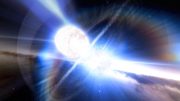
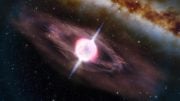
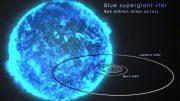
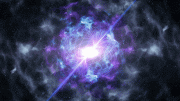
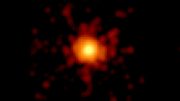
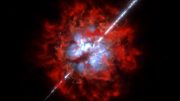
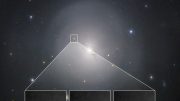
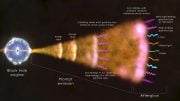
Imagine red-shift isn’t caused by distance, but by light decreasing over massive distances due to dust and other things (it is not empty as originally imagined). This was a true alternate theory early on and was jettisoned into space and yet James Webb is showing data inconsistent with theoretical predictions.
Now imagine the universe is not infinite (Seriously, how could it be if there was a Big Bang?) Shouldn’t it be a bubble? Regardless of the ultimate “shape” of the bubble, the thing about bubbles is they ultimately turn back on themselves like a loop (See scene in Matrix Revolutions where Neo goes out one side of the subway station in the pocket virtual reality and comes in the other side like a Pac-Man maze).
Now imagine the reason so many things about gravity and the like are wrong is because there was no Big Bang and perhaps our Universe isn’t expanding the way people imagine it to. Perhaps semi-events caused by boundary collisions with other bubble Universes only create the illusion of a Big Bang. Or what if the entire Universe is the inflationary side of a giant black hole from another Universe that is deflating? Microwave radiation in the background is leftover from the conversion of matter to energy in the black hole and spewing out into this Universe. Ultimately, the reaction will equalize and begin flowing in reverse and the other Universe being wiped out will exist again and ours will deflate. This process may be infinite. Life, the Universe and Everything may be a repeating LOOP. Infinity isn’t really infinite in a sense, but the a loop (alpha/omega/alpha/omega on and on).
The real question then is there anything or anyone outside the loop itself? Other bubble universes? Aliens who have advanced far enough to escape the loop and create their own reality? Or are we just inside a simulated virtual reality and it was all just to save processing time for an experiment looking for a random solution that takes many many loops to complete, making it only seem infinite (i.e. It doesn’t necessarily repeat exactly the same ala Deja Vu each loop).
Perhaps someone is looking for an answer to something and our “Universe” is the means to an end and consciousness is merely examining the results at various points throughout time from inside the simulation. Is that really an wonkier than a Big Bang coming out of “nothing” (or some imaginary “singularity” for no particular reason?).
Most Scientists don’t seem to realize their own belief system has become a religions and those that dare to question is are deemed heretics. True Science doesn’t really exist. Flawed Science run by humans with egos is another matter. The real problem is “Science” has accepted Big Bang Theory as IMMUTABLE LAW despite massive flaws in gravity that necessitated the creation of math fudges we call “Dark Energy” and “Dark Matter” to make the math work. It is doubtful that Nature is so absurdly complicated. But the ingrained belief in the Big Bang means that even suggesting we may have had it all wrong is tantamount to HERESEY and proponents are castigated and thrown out of the mainstream. They are CANCELED.
Has human EGO become so large that we cannot even conceive we may have an error in our theories? Until Quantum Theory and the Standard Model can be combined without a giant divide by zero error, I will rightly assume we have something WRONG. Too bad no one wants to fix it.